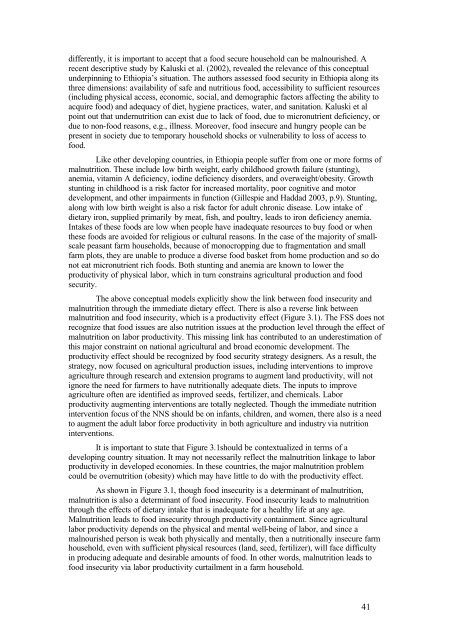An assessment of the causes of malnutrition in Ethiopia: A ...
An assessment of the causes of malnutrition in Ethiopia: A ...
An assessment of the causes of malnutrition in Ethiopia: A ...
You also want an ePaper? Increase the reach of your titles
YUMPU automatically turns print PDFs into web optimized ePapers that Google loves.
differently, it is important to accept that a food secure household can be malnourished. A<br />
recent descriptive study by Kaluski et al. (2002), revealed <strong>the</strong> relevance <strong>of</strong> this conceptual<br />
underp<strong>in</strong>n<strong>in</strong>g to <strong>Ethiopia</strong>’s situation. The authors assessed food security <strong>in</strong> <strong>Ethiopia</strong> along its<br />
three dimensions: availability <strong>of</strong> safe and nutritious food, accessibility to sufficient resources<br />
(<strong>in</strong>clud<strong>in</strong>g physical access, economic, social, and demographic factors affect<strong>in</strong>g <strong>the</strong> ability to<br />
acquire food) and adequacy <strong>of</strong> diet, hygiene practices, water, and sanitation. Kaluski et al<br />
po<strong>in</strong>t out that undernutrition can exist due to lack <strong>of</strong> food, due to micronutrient deficiency, or<br />
due to non-food reasons, e.g., illness. Moreover, food <strong>in</strong>secure and hungry people can be<br />
present <strong>in</strong> society due to temporary household shocks or vulnerability to loss <strong>of</strong> access to<br />
food.<br />
Like o<strong>the</strong>r develop<strong>in</strong>g countries, <strong>in</strong> <strong>Ethiopia</strong> people suffer from one or more forms <strong>of</strong><br />
<strong>malnutrition</strong>. These <strong>in</strong>clude low birth weight, early childhood growth failure (stunt<strong>in</strong>g),<br />
anemia, vitam<strong>in</strong> A deficiency, iod<strong>in</strong>e deficiency disorders, and overweight/obesity. Growth<br />
stunt<strong>in</strong>g <strong>in</strong> childhood is a risk factor for <strong>in</strong>creased mortality, poor cognitive and motor<br />
development, and o<strong>the</strong>r impairments <strong>in</strong> function (Gillespie and Haddad 2003, p.9). Stunt<strong>in</strong>g,<br />
along with low birth weight is also a risk factor for adult chronic disease. Low <strong>in</strong>take <strong>of</strong><br />
dietary iron, supplied primarily by meat, fish, and poultry, leads to iron deficiency anemia.<br />
Intakes <strong>of</strong> <strong>the</strong>se foods are low when people have <strong>in</strong>adequate resources to buy food or when<br />
<strong>the</strong>se foods are avoided for religious or cultural reasons. In <strong>the</strong> case <strong>of</strong> <strong>the</strong> majority <strong>of</strong> smallscale<br />
peasant farm households, because <strong>of</strong> monocropp<strong>in</strong>g due to fragmentation and small<br />
farm plots, <strong>the</strong>y are unable to produce a diverse food basket from home production and so do<br />
not eat micronutrient rich foods. Both stunt<strong>in</strong>g and anemia are known to lower <strong>the</strong><br />
productivity <strong>of</strong> physical labor, which <strong>in</strong> turn constra<strong>in</strong>s agricultural production and food<br />
security.<br />
The above conceptual models explicitly show <strong>the</strong> l<strong>in</strong>k between food <strong>in</strong>security and<br />
<strong>malnutrition</strong> through <strong>the</strong> immediate dietary effect. There is also a reverse l<strong>in</strong>k between<br />
<strong>malnutrition</strong> and food <strong>in</strong>security, which is a productivity effect (Figure 3.1). The FSS does not<br />
recognize that food issues are also nutrition issues at <strong>the</strong> production level through <strong>the</strong> effect <strong>of</strong><br />
<strong>malnutrition</strong> on labor productivity. This miss<strong>in</strong>g l<strong>in</strong>k has contributed to an underestimation <strong>of</strong><br />
this major constra<strong>in</strong>t on national agricultural and broad economic development. The<br />
productivity effect should be recognized by food security strategy designers. As a result, <strong>the</strong><br />
strategy, now focused on agricultural production issues, <strong>in</strong>clud<strong>in</strong>g <strong>in</strong>terventions to improve<br />
agriculture through research and extension programs to augment land productivity, will not<br />
ignore <strong>the</strong> need for farmers to have nutritionally adequate diets. The <strong>in</strong>puts to improve<br />
agriculture <strong>of</strong>ten are identified as improved seeds, fertilizer, and chemicals. Labor<br />
productivity augment<strong>in</strong>g <strong>in</strong>terventions are totally neglected. Though <strong>the</strong> immediate nutrition<br />
<strong>in</strong>tervention focus <strong>of</strong> <strong>the</strong> NNS should be on <strong>in</strong>fants, children, and women, <strong>the</strong>re also is a need<br />
to augment <strong>the</strong> adult labor force productivity <strong>in</strong> both agriculture and <strong>in</strong>dustry via nutrition<br />
<strong>in</strong>terventions.<br />
It is important to state that Figure 3.1should be contextualized <strong>in</strong> terms <strong>of</strong> a<br />
develop<strong>in</strong>g country situation. It may not necessarily reflect <strong>the</strong> <strong>malnutrition</strong> l<strong>in</strong>kage to labor<br />
productivity <strong>in</strong> developed economies. In <strong>the</strong>se countries, <strong>the</strong> major <strong>malnutrition</strong> problem<br />
could be overnutrition (obesity) which may have little to do with <strong>the</strong> productivity effect.<br />
As shown <strong>in</strong> Figure 3.1, though food <strong>in</strong>security is a determ<strong>in</strong>ant <strong>of</strong> <strong>malnutrition</strong>,<br />
<strong>malnutrition</strong> is also a determ<strong>in</strong>ant <strong>of</strong> food <strong>in</strong>security. Food <strong>in</strong>security leads to <strong>malnutrition</strong><br />
through <strong>the</strong> effects <strong>of</strong> dietary <strong>in</strong>take that is <strong>in</strong>adequate for a healthy life at any age.<br />
Malnutrition leads to food <strong>in</strong>security through productivity conta<strong>in</strong>ment. S<strong>in</strong>ce agricultural<br />
labor productivity depends on <strong>the</strong> physical and mental well-be<strong>in</strong>g <strong>of</strong> labor, and s<strong>in</strong>ce a<br />
malnourished person is weak both physically and mentally, <strong>the</strong>n a nutritionally <strong>in</strong>secure farm<br />
household, even with sufficient physical resources (land, seed, fertilizer), will face difficulty<br />
<strong>in</strong> produc<strong>in</strong>g adequate and desirable amounts <strong>of</strong> food. In o<strong>the</strong>r words, <strong>malnutrition</strong> leads to<br />
food <strong>in</strong>security via labor productivity curtailment <strong>in</strong> a farm household.<br />
41
















